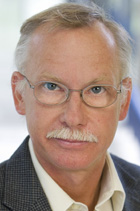Professor Franz-Ulrich Hartl was awarded the Dr H.P. Heineken Prize for Biochemistry and Biophysics 2010 for his contribution to the discovery of the role of ‘chaperones’ in protein folding.
Proteins can only guide cellular processes after they have become three-dimensional in shape. One of the key questions in biochemistry is how an amino acid chain folds itself into a three-dimensional shape, thereby becoming a protein, and how the resulting protein avoids becoming unfolded again and losing its function. It is because of Franz-Ulrich Hartl that we now understand the significance of chaperone molecules in this process. Chaperones are proteins that help other proteins fold themselves into the proper shape and remain that way. It was long assumed that proteins acquired their shape through a process of self-assembly, but Hartldiscovered that many of the thousands of different proteins in cellular fluid in fact depend on chaperones to guide them. He developed a series of ingenious experiments, both in vitro and in vivo, to explain in detail how chaperone-assisted protein folding works. In the first half of the 1990s, his publications in Nature led to a drastic overhaul of the basic principles of protein biogenesis, the fast-growing discipline that investigates protein formation.
Understanding the process of protein folding and unfolding has major implications. For example, a disruption in the folding mechanism leads to neurodegenerative diseases such as Parkinson’s and Huntington’s. Hartl and his research group are attempting to decipher these mechanisms. Ultimately, they hope to use the power of chaperones to combat disease and to assemble proteins in biotechnology.
Key publications
Cheng M.Y., Hartl F.U., Martin J., et al. 1989. ‘Mitochondrial heat-shock protein HSP60 is essential for assembly of proteins imported into yeast mitochondria.’ In: Nature 337: 620-625
Hartl F.U. 1996. ‘Molecular chaperones in cellular protein folding.’ In: Nature 381: 571-580
Hartl F.U. & Hayer-Hartl M. 2002. ‘Molecular chaperones in the cytosol: from nascent chain to folded protein.’ In: Science 295: 1852-1858
Tang Y.C., Chang H.C., Roeben A., et al. 2006. ‘Structural features of the GroEL-GroES nano-cage required for rapid folding of encapsulated protein.’ In: Cell 125: 903-914
Liu C.M., Young A.L., Starling-Windhof A., et al. 2010. ‘Coupled chaperone action in folding and assembly of hexadecameric Rubisco.’ In: Nature 463: 197-202
Biography
Franz-Ulrich Hartl was born in 1957 in Essen, Germany. He studied medicine at Heidelberg University, graduating summa cum laude in 1985. He also received his doctoral degree there for his dissertation on the role of hormones in the rat liver. In 1990, Hartl obtained his Dr. Med. Habil. from the University of Munich for his dissertation on protein assembly processes. Hartl went to the United States in 1989 as a postdoctoral fellow at the University of California (UCLA). In 1991, he moved to the Graduate School of Medical Sciences at Cornell University, where he worked as an instructor and researcher. From 1994 to 1997, he also worked as an associate investigator at the prestigious Howard Hughes Medical Institute for biomedical research. Hartl returned to Europe in 1997 after accepting an appointment as professor of physiological chemistry and managing director of the Max Planck Institute for Biochemistry in Martinsried, Germany.
Hartl has won many international awards and honours and is a member of the German Academy of Sciences, a foreign honorary member of the American Academy of Arts and Sciences and an honorary member of the Japanese Biochemical Society.
Video interview with Franz-Ulrich Hartl
